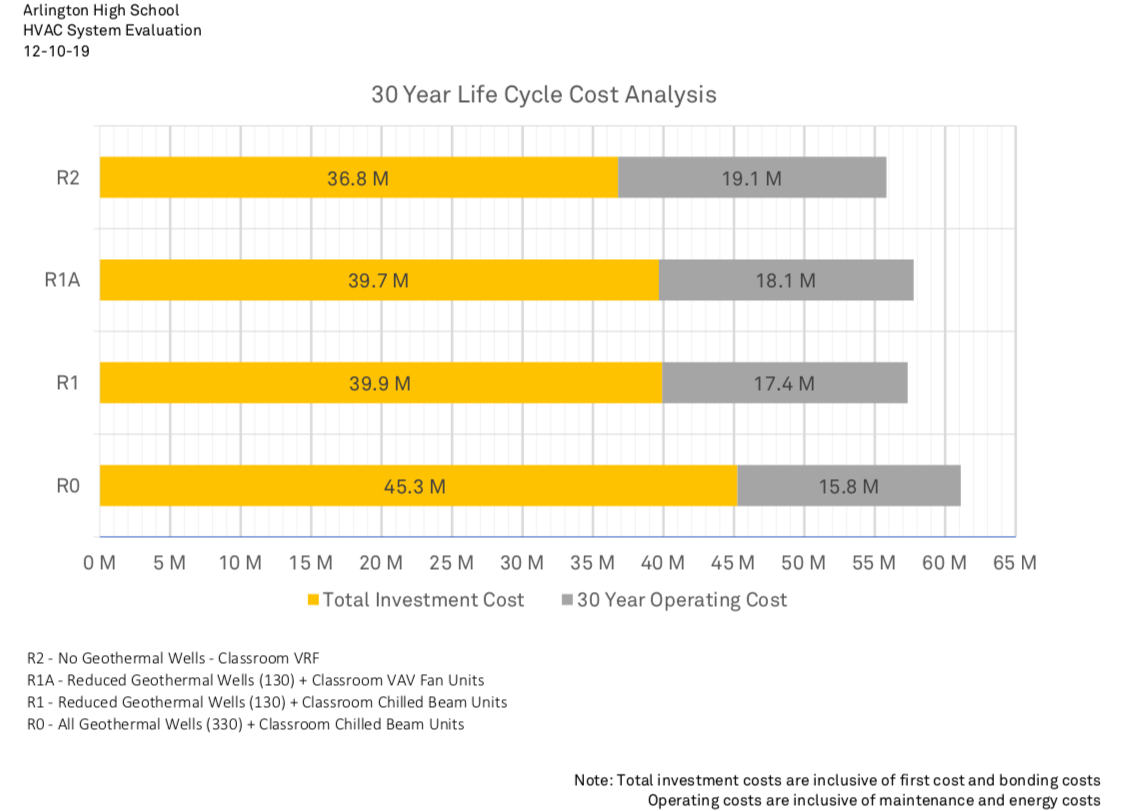If you’ve been following the Design Development process, you know that the Building Committee recently completed the difficult task of trimming $24.7 million from the budget to bring the project scope back in line with available funds. Fortunately, with the thoughtful deliberations of the Building Committee and the hard work of the design team, the core energy-related features have been retained with minimal impact to the total building energy use. The design changes being implemented are estimated to increase total building energy use by only about 3-4%, while resulting in several million dollars in up-front savings.
Mechanical System Changes
The primary change as it relates to energy use is to the mechanical systems used to heat and cool the building (also called “HVAC” for “heating, ventilation and air conditioning”). Because HVAC represents about 15% of the construction budget, it needed to be part of the value engineering analysis. The original HVAC design was based on a geothermal (“ground source”) heat recovery chiller heater system providing most of the heating and cooling to the building. Similar to ground-source heat pumps, but with additional heat recovery capabilities, this technology offers a very efficient all-electric solution, but at a price premium over other options. That premium is associated with the need to drill a network of wells (6-inch holes each approximately 500 feet deep) for a closed loop piping system to transfer heat to/from the building. For the AHS site, the price premium is further compounded by the need to manage contaminated soil. The initial design called for about 330 wells – enough to serve the majority of the building. The district administration and preschool wing was to be served by separate “variable refrigerant flow” (VRF) air-cooled heat pump systems, another very efficient all-electric option. For those familiar with “ductless mini-split” heat pumps for homes, VRF is the generic description of this technology. Its use is on a larger scale designed for commercial buildings.
After analyzing various HVAC options, the main change made was to reduce the number of geothermal wells from about 330 to 130. With the revised design, both classroom wings will continue to be served by the geothermal system, and district administration and the preschool will continue to be served by separate VRF systems. The remainder of the building (performing arts wing, athletics wing, and central spine) will instead be served by high-efficiency rooftop air-source heat pump units similar to the VRF systems described above, combined with heat recovery units. This retains the all-electric HVAC design while still maintaining high overall efficiency, but with reduced up front costs.
This design change resulted in a net reduction of about $4.8M to the construction budget (inclusive of markups). The main trade-off is that electricity use for heating and cooling is estimated to increase by about 10-15%. However, based on detailed energy modeling, heating and cooling only accounts for about one quarter of total electricity use, which is a testament to the energy efficient design being developed. Thus the reduction in geothermal wells should only increase total building electricity use by about 3-4%. Given the magnitude of the construction cost savings, this was deemed a reasonable trade-off by the Building Committee.
Lifecycle Cost Assessment
As part of the analysis of HVAC options, a 30-year lifecycle cost assessment (LCA) was conducted that included the initial capital cost, electricity, maintenance and equipment replacement. Assumptions were made for electricity price and price escalation, and town borrowing costs. Four options were considered: The original full geothermal system (labeled “R0” in the chart below), two variants for limiting the geothermal loop to both classroom wings as described above (“R1” and R1A”), and complete elimination of the geothermal loops, while still maintaining an all-electric building (“R2”).
When evaluated strictly on LCA costs, R1, R1A and R2 were found to be very close in value to one another, with only about a 3% difference between them. This should be considered within the range of uncertainty in an analysis of this type, making the three essentially equivalent on a 30-year LCA cost basis. R0 had the highest first cost and lowest operating cost, and a roughly 6-9% higher 30-year LCA cost than R1, R1A and R2. Even this could be seen as within the range of uncertainty of the LCA analysis. Thus, given the similarity in 30-year LCA costs, the Building Committee ultimately decided that reducing the number of geothermal wells was a reasonable compromise, given all the other constraints of the value engineering process.
Importantly, the option to completely eliminate the geothermal wells, which would have saved about $7.7M in initial construction costs (inclusive of markups), was rejected by the Building Committee because this option carried more technology risk, higher operating costs, and greater long-term exposure to possible electricity price increases. Not only would it be more difficult to make changes to this system in the future, it would have also added more rooftop equipment to the classroom wings, reducing the space available for solar panels.
What hasn’t changed
Even with these changes to the HVAC design, the three core energy-related sustainability features of the building have been retained:
1. Build a highly energy efficient building
No changes were made to the lighting systems, building controls or building envelope (exterior, insulation, windows), that will materially reduce the energy efficiency of the building. The building will still be very energy efficient, using approximately half the site energy per square foot as the current high school.
2. Design for an all-electric building
The Building Committee remains committed to positioning the new school for a future free of fossil fuels. Thus, the building design remains all-electric. This puts the building on a path to net-zero carbon operation as the electricity grid decarbonizes over time. Designing now for all-electric operation also means avoiding potentially costly upgrades later.
3. Maximize onsite renewable energy production
The site will still make extensive use of solar photovoltaic (PV) panels, including rooftop arrays and a canopy over one of the two main parking lots. The town is working with AMERESCO, the company that owns and maintains the existing solar arrays on six schools, including the current AHS. They are designing a cost-effective PV system that will add about 1,000 kilowatts (kW) of solar capacity to the approximately 300 kW currently on AHS. Given the compact nature of the new building and the site, this is a significant increase. The combined capacity should provide about one third of the total annual electricity used by the building. Importantly, this will also result in cost savings and energy price stability. The 20-year power purchase agreement signed with AMERESCO will provide the solar electricity at a price below that of grid power and with no escalation, whereas grid power has historically increased about 2-4% per year.
To summarize, the Building Committee had to make some significant changes to the HVAC design as part of the value engineering process. Given the budget gap that needed to be filled, had the HVAC design been retained as is, a significant amount of building elements and features that support the educational program would have needed to be removed from the project scope. It is important to reiterate that, even with the reduced number of geothermal wells, the core sustainability objectives of the project have not changed and are still being met.
Additional Resources
- Ponderings Blog: Budget Adjustments Explained
- Ponderings Blog: What is Value Engineering?
- Committee adjusts project to meet budget
- Sustainability for the New AHS – An Update
- Sustainability at the new AHS
The author, Ryan Katofsky, is a member of the AHS Building Committee and chair of the Sustainability Subcommittee.


